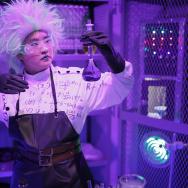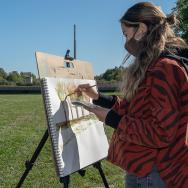Through the first eight weeks of an unprecedented academic year, University of Chicago students and instructors have brought current events into the classroom—and taken their classroom out into the world.
From the ecology of nearby Jackson Park to the implications of the ongoing global pandemic, the Autumn Quarter curriculum has helped contextualize some of the most important issues of the moment. Along the way, students have also formed lasting bonds, embedding themselves in campus life while staying safe.
Outdoor field trips
Gathering in Jackson Park last month, a group of University of Chicago students dipped their nets into the water—trawling for fish, insects and other living creatures.
The outing was part of “Ecology and Conservation,” a class taught by Prof. Catherine Pfister and Sr. Lect. Eric Larsen to focus on ecological theory and conservation biology while enabling safe field work. On Oct. 22, the two instructors led their students to Jackson Park’s Columbia Basin, where they sampled aquatic diversity in order to learn about the microbiome and its various functions.
Masked and socially-distanced, the group spent the day netting, seining and swabbing species, which were then put in a fluid. Afterward, the students set off for their residence halls, where they pipetted samples onto well plates pre-loaded with nutrients to determine if a microbiome would grow.
This quarter, the class has also taken field trips to Midewin National Tallgrass Prairie to look at bison as part of a restoration project, and to Indiana Dunes National Park to quantify the successional sequence in plants.
When planning the course, Pfister and Larsen knew they wanted to preserve the outdoor, hands-on component for students.
“That's what was exciting to both of us about biology when we were that age,” said Pfister. “I think that's an essential part of training biologists in this era. They have to know the biodiversity. They have to know how to do some of these methods.”
In taking the class, third-year Julius Tabin focused on connecting his past knowledge of science to a wider global history of ecology and conservation.
“It’s really important to confront what we as humans are doing to the environment,” said Tabin, who is double-majoring in biology and egyptology. “That’s not the only thing the class is about, but I think it’s important to show how we might be able to minimize our impacts, and how can we protect vulnerable species.”
Discussing the presidential race
A course on the presidential election is giving students the opportunity to engage in vigorous examination of the presidential race, the electoral process and specific campaign issues, while elevating deliberative discourse and avoiding polarization and division.
To provide a framework for productive discussion of the election, Leila Brammer had students develop an area of expertise, both via their own research and by reaching out to academics and professionals, synthesizing their knowledge, and presenting those perspectives to their fellow students.
“I constructed the course to be a dynamic space in which students could develop and confidently speak with expertise, consider varied perspectives, test ideas and make sense of the election together,” said Brammer, a senior instructional professor.
Offered through the Parrhesia Program for Public Discourse, the class aligns with UChicago’s tradition of free expression and inclusive discussion while enabling students to practice public speaking.
“The opportunity to critically analyze events at the moment they are happening is unique, and particularly under Prof. Brammer’s guidance, it’s hard to pass up,” said Sofia Barnett, a fourth-year student in the College.
An undergraduate TA for the general election class this fall, she also took Brammer’s course on the presidential primary last spring. Barnett, a political science major, said she has been impressed every day by her peers’ insights and viewpoints. Other students concurred.
“Every person selected an area of expertise with which to familiarize themselves throughout the class, and topics ranged from mail-in voting to the Supreme Court to reproductive rights,” said Eliana Melmed, a fourth-year undergraduate majoring in public policy. “I really appreciated the interactive discussion element, because that kind of structure was more engaging over Zoom.”
The historic nature of this election, Melmed added, only underscored the importance of those discussions: “It’s a class I’ll remember for a long time.”
Brammer will teach another course next quarter on political rhetoric and presidential transitions.
History of pandemics
Photo essays, neighborhood maps and Albert Camus’ The Plague. All these are elements of a new class on pandemics—one that weaves together history, urban design and culture.
The course was, in part, a product of necessity. Back in spring, Evan Carver had originally planned to teach a Chicago-based studio class that included site visits. When those sorts of trips were no longer possible due to the spread of COVID-19, he decided to instead launch “Pandemics, Urban Space and Public Life”—which he has taught again this quarter.
“Pandemics seem to touch all aspects of social life, which can be terrifying and overwhelming,” said Carver, an assistant instructional professor in the Program on the Global Environment. “But this is not the first pandemic that has caused humans to think hard about the structure of urban societies. There’s a long history of scholarship—and big, complex ideas to engage with.”
To bring a sense of focus to his syllabus, Carver decided to look historically and identify a series of case studies. Points of focus include the influence that tuberculosis had on modern design and architecture, and the failed response of French colonial powers to a plague outbreak in Hanoi, Vietnam. Such examples, Carver said, can reveal how diseases exacerbate social inequality, and how policy responses intersect with race or class.
The course also gave students the opportunity to reflect on the pandemic from a more personal perspective. One assignment involved a photo essay created over several weeks, while another asked students to imagine “a map of your community as you experience it under coronavirus”—which could focus on everything from their daily routine indoors to the places and people they miss.
The final project also encourages creativity, pushing the students to think about policy interventions in their city amid the pandemic. That project can take the form of a traditional academic paper, or explore mediums such as graphic memoir and film.
“The idea is that they would pick a project that is most meaningful to them,” Carver said.
‘A special place’
Life on campus may feel constrained at times due to social distancing measures, but residence halls have still fostered unique ways to connect. This quarter at Burton-Judson Courts, undergraduate residents have had the opportunity to participate in activities like sound therapy, drum circles, yoga and morning runs.
“Our goal is to give the students a feeling of what a special place Burton-Judson is,” said Andrew Siegel, who lived in the residence hall in 1985 and now serves as a resident dean alongside his wife Patty Jones. “A silver lining of the pandemic is that our reach is less broad, but in many cases the connections are deeper and more meaningful.”
Just last week, residents attended a clay workshop held over Zoom and led by Evanston-based potter Joanna Kramer of Ware Ceramics. After resident deans distributed pottery kits, students signed on to a Zoom call to follow Kramer’s instructions and demonstrations. Focusing on coiled bowls, the event was the second installment of a pottery workshop focused on practical design.
“Earlier this quarter we hand-molded mugs, and I use mine for hot chocolate breaks when studying,” said first-year Amanda Chacón. “I was enthusiastic about the chance to make something else.”
Future virtual events include a chocolate tasting, and classes in flower arrangements and painting. Because the events are held online, they are also accessible to students not currently in the residence halls—such as fourth-year Cherry Ying, who spent three years in Burton-Judson but is now living off-campus.
“With activities like this latest pottery event, I feel like I am still a part of the Burton-Judson community,” Ying said.
—This story includes contributions from Lily Levine, Max Witynski, Jack Wang and Ege Yalcindag.

